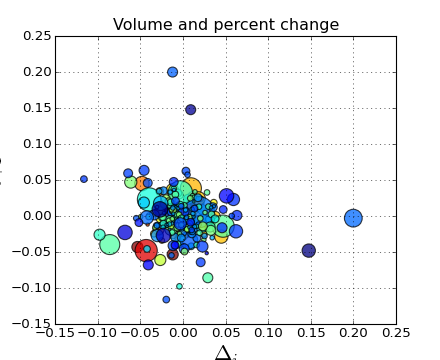

(Source code, png, hires.png, pdf)

"""
make a scatter plot with varying color and size arguments
"""
import matplotlib
import numpy as np
import matplotlib.pyplot as plt
import matplotlib.mlab as mlab
import matplotlib.cbook as cbook
# load a numpy record array from yahoo csv data with fields date,
# open, close, volume, adj_close from the mpl-data/example directory.
# The record array stores python datetime.date as an object array in
# the date column
datafile = cbook.get_sample_data('goog.npy')
r = np.load(datafile).view(np.recarray)
r = r[-250:] # get the most recent 250 trading days
delta1 = np.diff(r.adj_close)/r.adj_close[:-1]
# size in points ^2
volume = (15*r.volume[:-2]/r.volume[0])**2
close = 0.003*r.close[:-2]/0.003*r.open[:-2]
fig = plt.figure()
ax = fig.add_subplot(111)
ax.scatter(delta1[:-1], delta1[1:], c=close, s=volume, alpha=0.75)
#ticks = arange(-0.06, 0.061, 0.02)
#xticks(ticks)
#yticks(ticks)
ax.set_xlabel(r'$\Delta_i$', fontsize=20)
ax.set_ylabel(r'$\Delta_{i+1}$', fontsize=20)
ax.set_title('Volume and percent change')
ax.grid(True)
plt.show()
Keywords: python, matplotlib, pylab, example, codex (see Search examples)